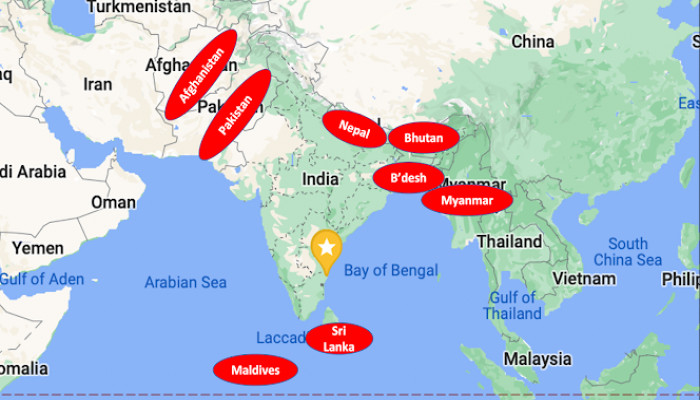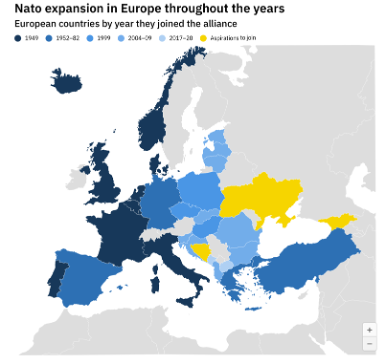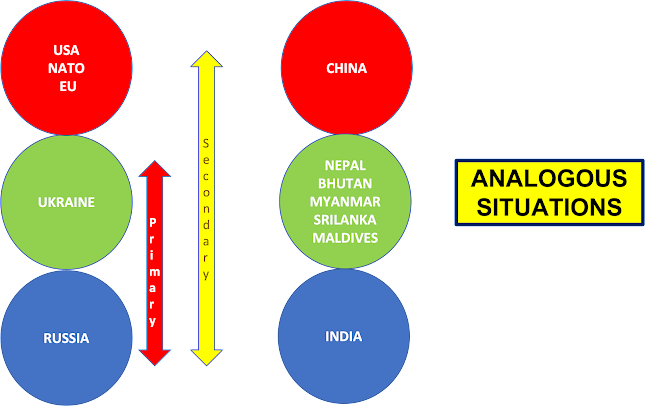Russo-Ukrainian Conflict and India’s Neighbourhood First Policy
- In Military & Strategic Affairs
- 12:44 PM, Apr 11, 2022
- LT GEN P R SHANKAR (Retd)
India is rising, but through challenging times. The shadows cast by the Pandemic and the Ukrainian conflict are conflated and are posing peculiar problems by throwing up issues in the immediate neighborhood and the extra regional environment. The Ukrainian Conflict, in particular portends global geopolitical uncertainty and economic turmoil. The conflict has caused India to do a tight rope walk to strike a balance between the trans-Atlantic consolidation of the West and the emerging Russia-China axis.
In the immediate vicinity one sees turmoil in Pakistan, Sri Lanka, Afghanistan, and Myanmar. While each country has a different problem, the common extra regional denominator in the immediate neighborhood is the overbearing Chinese influence. Within this overall environment, if India is to continue to grow there is an undeniable need for it to manage its neighborhood first. A secure neighborhood will be fundamental to its international rise. Conversely a ‘rising India’ cannot exist in a ‘failing or an alienated neighbourhood’ as I had expounded in my earlier article Russian Lessons on Neighbourhood First. The Russo-Ukrainian situation and the factors leading to the conflict have a striking analogy with our situation. It will do us well to understand the similarities to enable us to handle the neighbourhood better.
The first issue which merits examination is the core reason for Russia to go to war with Ukraine, which I have outlined in my article Russo-UkrainianWar: Vanquished Victors. Despite assurances from USA to Russia, since 1990, that NATO would not expand eastwards towards Russia, the opposite happened. NATO expanded eastwards in multiple tranches. The first tranche was in 1999 when Poland, Hungary and the Czech Republic joined NATO. The second round of NATO expansion took place in 2004, when Bulgaria, Slovenia, Slovakia, Romania, Lithuania, Estonia and Latvia joined in. Expansion continued till as late as 2017. This was done to contain Russia so that it does not revive into a major power like the erstwhile USSR.
Russia being the largest country territorially, is not only self-sufficient but a net exporter of technology, energy, food grains and many critical metals. It had the full potential to grow into a superpower, in time, to rival USA and China. At the time of the first two expansions, Russia could not do much about it due to its inherent weaknesses. For the past decade and a half, the USA and NATO have been contemplating another expansion to the east by enticing Ukraine, Bosnia and Herzegovina and Georgia into their fold.
Ukraine on its part has also been wanting to join NATO and EU ever since the US supported the colour revolution of 2014. However, a resurgent Russia had been against it and has repeatedly expressed that Ukrainian aspiration to join NATO was a core security concern. NATO drills or deployment of weapons systems in close vicinity to Russian territory constitute a stated red line. The US however, continued its push for eastward expansion of NATO to contain Russia despite all this. Ultimately, when things came to a head, Russia invaded Ukraine to keep it permanently out of NATO and ensure its complete neutrality. In doing so, Russia demonstrated a clear intent to draw a line in the sand where its core security concerns were involved and to protect its neighbourhood. While the primary conflict on ground is in Ukraine the larger conflict is between Russia and the West.
Analogous to the USA/NATO – Ukraine -Russia construct, there is a clear parallel in the China-Nepal/Bhutan/Sri Lanka/Myanmar – India construct. Nepal, Bhutan, Sri Lanka, Maldives, Bangladesh, and Myanmar are nations in our immediate neighborhood where China has been making inroads. Pakistan is complicit with China to pose a collusive threat to India. The geopolitical vacuum in Afghanistan is being attempted to be filled up by China and Pakistan.
Pakistan and Afghanistan need a different approach and are not being discussed further. When one examines the rest of India’s neighborhood further, it is amply clear that all of them have had bouts of instability and are prone to turmoil. Our relationship with them has been episodic with highs and lows. One also sees that these smaller nations, once under India’s influence have started hedging their bets with other nations and particularly with China. As a result, there is an indirect/insidious threat from China through these nations. There is also an issue of ethnic overflows from these nations into India in their periods of turbulence. India faces a continuous challenge to keeps its neighborhood in its sphere of influence and keep China out of them. While the overarching contest is between China and India, the subsidiary friction is between India and its neighbors. \
There are two fundamental analogies which can be drawn out. In the first instance, just as a strong USA and NATO ignored a weakened Russia to expand eastward, an economically stronger China has expanded into our neighborhood at the expense of a relatively weaker India. In doing so it has established its influence and diluted India’s influence in all its neighbors. However, in the recent times, India is growing in strength while China is plateauing. Hence India is pushing back. This push back is like the actions taken by a resurgent Russia in the past decade to thwart NATO/USA and regain its sphere of influence. As it stands, the Chinese influence in our neighborhood has started ebbing slightly. However, it remains a competitive scenario where jostling for influence will continue.
The second facet is that India faces physical expansion of Chinese activities close to its borders. Many of them pose a grave security threat to it in a very similar way that NATO deployment in Ukraine would have posed to Russia. Many examples come to mind. The first being that China encroached into Bhutan by force to gain control of the Doklam area to get a clear look into the Siliguri corridor. India had to intervene physically and prevent China from progressing further.
The second example is that of Hambantota. When Hambantota was going under Chinese lease, it was ensured that the port would not be used for military purposes at the insistence of India. Also recently, a renewable energy project contract in the Trincomalee area, near the southern coast of India, albeit on Sri Lankan territory was blocked from being awarded to the Chinese on security grounds. It has been since diverted to India. Hitherto fore, India’s efforts at keeping China at arm’s length from a core security perspective have been successful. However, there are no guarantees that this situation will continue.
Let us see a few situations which are more akin to the Ukraine case which could occur in the future. In the first case, it is universally known that China is actively pursuing the CMEC (China Myanmar Economic Corridor) to culminate in the Kyaukphyu port in the Bay of Bengal. If that happens, China will have a naval base in the proximity of North Andaman Islands. This will operationalize its quest for a two-ocean access, which is a prerequisite for China to gain superpower status. Further, completion of the CMEC will also imply that China will have the logistic capability to militarily assail India through Nagaland or Manipur to completely turn our defenses in an outflanking move.
In the second situation, what if China persuades Nepal to deploy PLA and weapons in the Terai region bordering Bihar and UP? China will be on our doorstep to threaten the Gangetic plains having side stepped our military deployed in the Himalayas. In both cases, we would have been caught flat footed and our security will be in severe jeopardy. The Eastern Ladakh intrusions will seem a picnic in comparison.
In both these situations, what will be our reaction? Will we attack our neighbor or take up a fight with China? In this process some redlines would have been crossed. Before that some trip lines would have also been breached. Have we communicated them out to our neighbors? Have we conveyed to them our security concerns and informed them about the redlines which they cannot cross? Reciprocally, countries in India’s strategic neighbourhood need to look at India for their security. Are they doing so?
Many more such situations can be developed, and war gamed only to find that something more unexpected can happen. To thwart such a development and be able to handle it, we need to put more thought into our neighborhood first policy. It is not being suggested that we threaten or attack our neighbor’s hereafter. What is required to be thought through is that our ‘Neighborhood First’ policy needs to ensure that prevention is better than cure and that an implied threat is better than an applied threat. We need to dangle an Indian carrot while conveying that the Russian stick can be applied. What does this entail?
Our relationship with each of our neighbours will remain case sensitive once broad common principles are applied. The overall effort should be that while India might have a ‘Neighbourhood First’ policy, we need to elicit a spontaneous reciprocity from our neighbours who should be able to think of a ‘India First’ domestic policy from their side. India must have a long term comprehensive neighbourhood policy with country specific mandates. Our neighbours have to be dealt at two levels. At one level, the relationship between India and any neighbour has to be on international norms.
At another level, the relationship with the neighbour has to be at local level through adjoining/ contiguous states. Hence the policy should be evolved in consultation with states which have borders with our neighbours. Ultimately the policy must be binding on the States and Centre. All the Ministries must also adhere to the policy. We should not get into an India vs India situation where the state does what it wants and the centre is on another track altogether. The bitter experience of Sri Lanka in the past must never be repeated.
From a wider perspective, India should never get into a Russia- Ukraine animosity kind of a situation. That is possible only if we build upon shared values and our historic cum cultural ties with all our neighbours. We need to build interdependencies and take all our neighbours, who are far smaller than us, along with us as we progress. We need to ensure this without impinging upon their sovereignty. We need to give them slack as also know when to tighten it.
Interdependencies and ties can be deepened on shared ethnicities, culture, religion, sports, trade, commerce, economics, health, and development activities. India should be the go-to entity for all our neighbours in case of HADR and other emergent situations. India and its neighbours should have a shared security architecture and deep military ties. Many more issues can be thought of as I have already indicated in my earlier article Russian Lessons on Neighbourhood First .
The Russo-Ukrainian conflict gives pointers as to how to approach our neighbourhood as well the pitfalls in dealing with them. The fundamental issue which emerges is that India must share its progress with its neighbours. Our neighbours must draw on our strength rather than be intimidated by it. When India can take all its neighbours along, the Chinese influence will automatically wane. The current situation in Sri Lanka, where the Chinese ‘Debt Trapping’ diplomacy is being exposed and Indian help is being universally acknowledged by the people is a great platform to re-start from.
All the images are provided by the author.









Comments